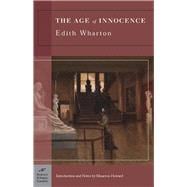From Maureen Howard's Introduction to The Age of Innocence
The Age of Innocence is Edith Wharton's most romantic novel, yet our expectations for her lovers, Ellen Olenska and Newland Archer, are disappointed at every turn. Wharton's genius lies in offering the pleasure of a romance, then engaging the reader in a stunning exploration of boundaries between the demands of society and personal freedom, illicit passion and moral responsibility. In this novel of bold design, we are the innocents unaware of the more demanding rewards to come, just as the readers of the Pictorial Review were as the monthly installments appeared in 1920. Luring us with the high comic tone of the opening chapters, Wharton admits us to Newland Archer's dreamy certainty about love and marriage, all that lies ahead in an ordered universe, his little world of fashionable New York in the 1870s.
The strict rules of that society are rendered in detail-the moments when talk is allowed during the opera, the prescribed hours for afternoon visits, the lilies of the valley that must be sent to May Welland, the untainted girl who is about to become Newland's fiancée. In the opening scenes there are two observers, Wharton and Newland. The novelist is full of historical information about the city of her childhood and the customs of her privileged class. New York, constructed out of memory and verified by research, is not a discarded back-lot affair of an old Hollywood studio, but a place that must come alive for the writer as well as her readers. This lost world, lavish with particulars of dress, food, wine, manners, is weighted with an abundance of reality, all the furnishings of excessively indulged, overly secure lives. But as the writer calls up her New York of fifty years earlier, Newland Archer also instructs us in the mores of the best of families and the questionable behavior of flashy intruders on the rise. This dual perspective is playful: the novelist assessing her man, placing him in a rarefied world that he too finds narrow and amusing, though all the while he is a player in it.
Wharton's education of the reader continues as each character comes on stage. Newland is a self-declared dilettante, May an innocent thing, Countess Olenska an expatriate with a problematic past. Julius Beaufort, a freewheeling climber, may be the scoundrel of the piece. The novelist is knowingly leading us into melodrama, the dominant mode of the popular theater of the age she recreates, a theater of plays in which good and evil were clearly sorted out, not tainted by moral ambiguity or shaded feelings. As we read what has so often been praised as an historical novel, we must bear in mind the year it was composed, 1919. The Age of Innocence calls upon history to inform the present, and Wharton portrays a cast of clueless characters who could not conceive the slaughter of World War I or President Wilson's ill-fated proposal for the League of Nations. Turning back to the untroubled era of her childhood, she entertains with a predictable old form that is a lure, even a joke, but not on the reader. We are drawn by the broad humor at the outset of the novel to the discovery of a darker story without the simple solutions of melodrama. Edith Wharton had a gift for comedy that has often been obscured by a reverence for the elegant lady novelist or probing for feminist concerns in her work.
The opening chapters of The Age of Innocence are given to caricature and sweeping mockery. In fact, Wharton mentions Dickens and Thackeray, whose comic exaggerations she must have had in mind. Newland Archer, superior and instructional, is foolish in the romantic projections of his marriage to May: "'We'll read Faust together . . . by the Italian lakes . . .' he thought, somewhat hazily confusing the scene of his projected honeymoon with the masterpieces of literature which it would be his manly privilege to reveal to his bride." An understanding of Faust, the most popular opera of the nineteenth century, with its unbridled passion and soul-selling contract, will presumably improve May: "He did not in the least wish the future Mrs. Newland Archer to be a simpleton." Meanwhile, Nilsson, the great diva, sings gloriously in the tacky garden scenery of the opera house. Early on, we suspect there will be no paradise and little innocence as the next months' installments of the novel unfold. May, corseted in virginal white with a "modest tulle tucker" over her bosom, is too good to be true. It may be difficult for a contemporary reader to find Ellen Olenska, fated to be May's rival, shocking in that revealing Empire dress, "like a nightgown," according to Newland's sister.
